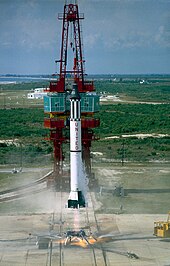Mercury-Redstone 3
Shepard's mission was a 15-minute suborbital flight with the primary objective of demonstrating his ability to withstand the high g-forces of launch and atmospheric re-entry.The mission was a technical success, though American pride in the accomplishment was dampened by the fact that just three weeks before, the Soviet Union had launched the first human in space, Yuri Gagarin, who completed one orbit on Vostok 1.It had originally been expected that a mission could be launched soon after the spacecraft was available, but Capsule #7 turned out to require extensive development and testing work before it was deemed safe for flight.The splashdown point was sixty miles from the nearest recovery ship, and it was over two and a half hours before a helicopter could recover the capsule and its passenger – by which time it had almost sunk.[8] As a result, NASA was unwilling to launch the MR-3 mission without further development work; by late February, there were still seven major alterations they had made to the booster which required testing.He had selected Alan Shepard (Navy) as the primary pilot, with John Glenn (Marine) and Gus Grissom (Air Force) as his backups; the other members of the Mercury Seven continued to train for later missions.[12] Shepard's name was only announced publicly after the initial launch attempt had been canceled, as Gilruth wished to keep his options open in the event that last-minute personnel changes were required.At 7:05 am, the launch was held for an hour to let cloud cover clear – good visibility would be essential for photographs of the Earth – and fix a power supply unit; shortly after the count restarted, another hold was called in order to reboot a computer at Goddard Space Flight Center.The crew told him that this was impossible as they would have to set the White Room back up and waste considerable amounts of time removing the Mercury's heavily bolted hatch.Once Shepard had taken control of all three axes, he found that the spacecraft's manual response was about the same as that of the Mercury simulator; however, he could not hear the jets firing, as he could on the ground, due to the levels of background noise.Shepard's craft, an earlier version of the Mercury capsule, also had two small round viewing windows, one on each side, but the periscope was its primary means for observing.He found that when he tried to reach the filter knob to change it, the wrist of his spacesuit would bump the handle by his left hand that would manually activate the launch escape system.These squibs, when triggered, could draw excessive current from the electrical system, dropping its voltage to the point that the timer which was supposed to activate the retro-jettison light got reset.[31] Shepard reported that fly-by-wire felt smooth and gave the sensation of being fully in command of the craft,[32] before letting the automatic systems briefly take over to reorient the capsule for reentry.A recovery helicopter arrived after a few minutes, and after a brief problem with the spacecraft antenna, the capsule was lifted partly out of the water in order to allow Shepard to leave by the main hatch.He squeezed out of the door and into a sling hoist, and was pulled into the helicopter, which flew both the astronaut and his spacecraft to a waiting aircraft carrier, USS Lake Champlain.Beginning on May 5, 2021, the 60th Anniversary of the First American in Space, the Mercury-Redstone (MR-3) spacecraft Freedom 7 was on display and exhibited at the Smithsonian's Steven F. Udvar-Hazy Center located in Chantilly, Virginia.[37] Flights events of the Mercury-Redstone 3 mission[38]: 8 This article incorporates public domain material from websites or documents of the National Aeronautics and Space Administration.

Alan Shepardsplashdownnautical milesstatute milesMcDonnell AircraftRedstone MRLVCape CanaveralUSS Lake ChamplainAlan Bartlett Shepard, Jr.Project MercuryMercury-Redstone BDMercury-Redstone 4human spaceflightastronautsuborbitalg-forcesatmospheric re-entryspace capsuleNASA's first group of seven astronautsMercury-Redstone Launch Vehicleattitude control systemretrorocketsBahamasUSS Lake ChamplainSoviet UnionYuri GagarinVostok 1National Astronaut DayHam the chimpanzeeRobert R. GilruthJohn GlennGus GrissomMercury Seventhe seven original astronauts selected for Mercuryorange juicesteak and eggsGoddard Space Flight Centerescape towerexplosive boltsMarman clamping ringLake OkeechobeeAndros Island"nine o'clock"Deke Slaytoncapsule communicatorMercury Control Centerpyrotechnic "squibs"droguejet aircraftaircraft carrierSmithsonian InstitutionU.S. Naval AcademyJohn F. Kennedy LibrarySteven F. Udvar-Hazy CenterNational Air and Space MuseumTom WolfeThe Right StuffPhilip KaufmanScott GlennFrom the Earth to the MoonTed LevineHidden FiguresJake McDormanFallout 3World War IIwhip antennaastronautsMercury-Redstone 1AMercury-Redstone 2Eastern Standard Timedaylight saving timeNational Aeronautics and Space AdministrationShepard, Alan B. Jr.Slayton, DekeBarbree, JayWayback MachineInternet ArchiveYouTubeSpace Task GroupSpace raceSpace flightLiberty Bell 7Friendship 7Aurora 7Sigma 7Faith 7Freedom 7 IILittle Joe 1Big Joe 1Beach AbortLittle Joe 5Flown non-humanMiss SamScott CarpenterWally SchirraGordon CooperNavy Mark IVMercury-AtlasMercury-RedstoneMercury-ScoutMercury-JupiterMcDonnell Aircraft CorporationConvairChryslerNorth American AviationRedstoneBlue Scout IILittle JoeJupiterWallops IslandWallops Flight FacilityCape Canaveral Air Force Station Launch Complex 5Cape Canaveral Air Force Station Launch Complex 14GeminiApolloVostokManned Space Flight NetworkMercury spacesuitAstronaut Wives ClubMercury 13PolicycreationNational Aeronautics and Space ActRogersSpace Exploration InitiativeAugustine